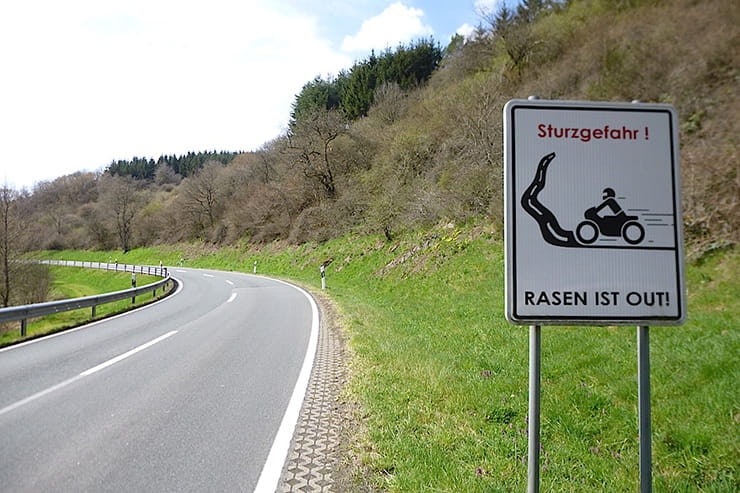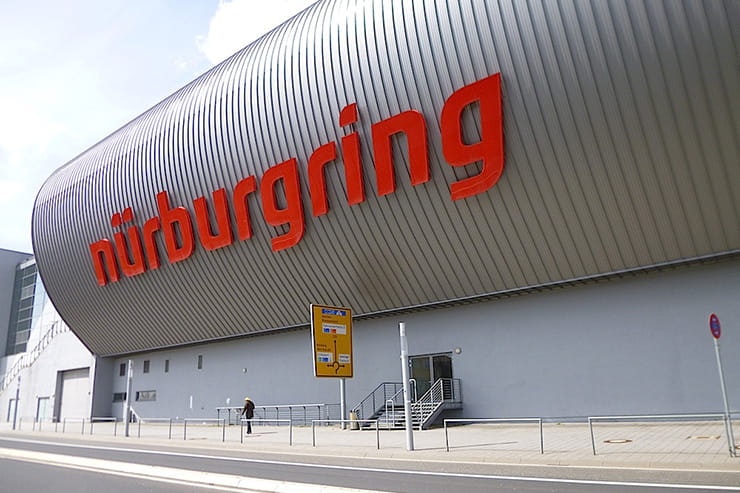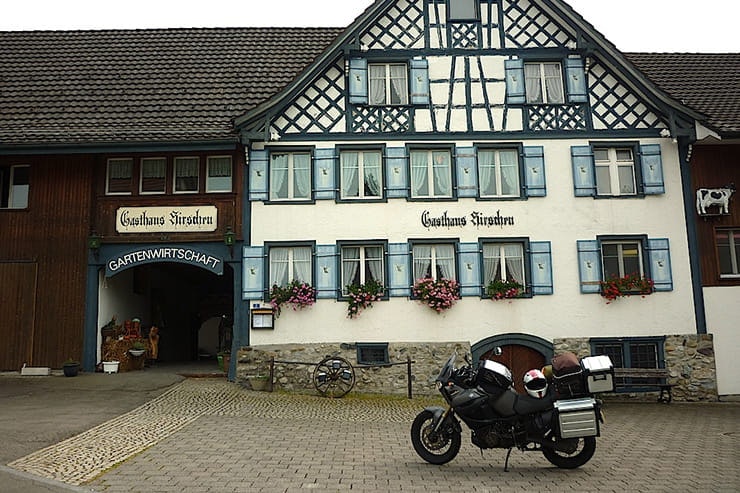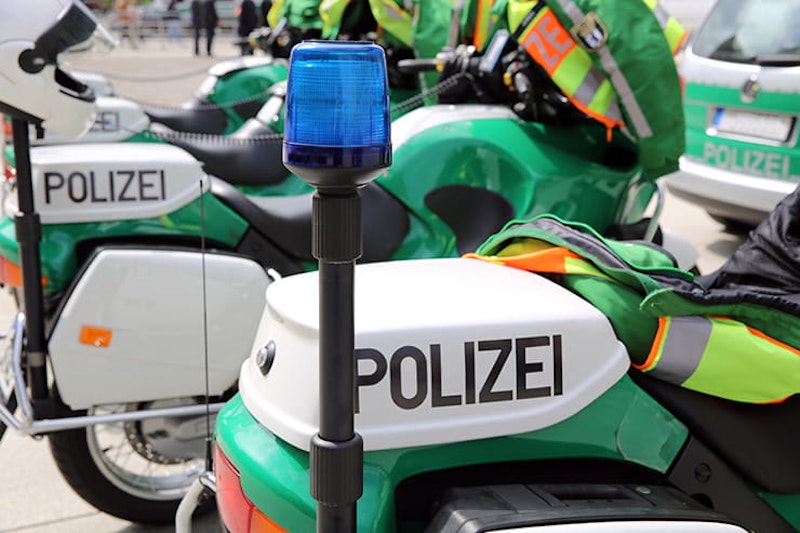How to ride in Germany: Speed limits, documents, the law
By Kev Raymond
Motorcycle Journalist
01.05.2025
Anyone with a big, fast bike will have been tempted by the thought of a trip to that mythical land where you can go as fast as you like without fear of a nicking, but there's a lot more to Germany than the Autobahn.
From the Eifel Mountains in the south, to the Harz range in the north, and from the wonderful Schwarzwald (AKA the Black Forest) to the rugged Baltic coast, it's a great place to ride a bike. Best do a bit of homework before you go though…
For a full checklist of paperwork and equipment needed to ride in the EU post-Brexit, see our guide here.
What’s the speed limit in Germany?
Urban limits are 50km/h (30mph) unless posted otherwise – the start of an urban limit is effectively signalled by the town name sign, and the end by the same name with a red diagonal line through it. Within those areas there will often be 30km/h (18mph) limits in residential areas or near schools etc, and it's worth pointing out that you're legally required to exercise extra caution near children and elderly people, and be able to stop safely without danger of collision if necessary. Outside urban areas the national speed limit on normal A-roads is 100km/h (6mph) for cars and bikes. For motorways, see below.
If you see a blue sign with white lettering saying, for example: '80-120km/h' that indicates an advisory speed range for that stretch of road.
What are the police like in Germany?
The German system of policing is fiendishly complex, with powers vested mostly in the local states rather than at national level. That's meant in the past that different states would have different uniforms and police vehicle liveries, the latter making it harder to work out whether that dot in your mirror is something to worry about. These days it's pretty much standardised as silver and blue for vehicles (although Bavaria and Saarland have yet to comply and use green and white or silver) so keep any eye out.
Unmarked vehicles are also common, but almost always German-made.
On-the-spot fines of up to 35 euros for minor offences are the norm in Germany. For anything above that – which basically means more than about 25km/h (15mph) over the limit – they can take more as a deposit against the likely higher fine, which will be imposed by a court. If you refuse to pay (or can't for whatever reason) they can impound your bike until you do.
What kit and documents do I need to ride in Germany?
You need your driving licence (plus 1968 pattern International Driving Permit if you still have a paper licence or one issued by the Isle of Man, Gibraltar or Channel Islands), passport (issued less than 10 years previously and with more than three months left to run on your return date), registration document (and form V103 from your finance company if appropriate) and proof of insurance (you no longer need a Green Card). You also obviously need your passport. You must be able to present the originals of any of these, not photocopies, on demand if pulled over – failure to do so is punishable by an immediate fine.
Some sources will tell you that you also need an Umweltplakette (Emissions Sticker) to enter low emissions zones in many German cities. That's true for cars, but for the moment at least, motorcycles are exempt. The same sources say you have to carry a warning triangle and a first aid kit, but again that's not true for motorcycles (although the latter is a good idea anyway).
You must ride with dipped beam on at all times.
Breakdown insurance is highly recommended. Read the small print though; many policies insist you buy cover for the entire journey, so cover must include the day that you leave home and not just begin as you land in the EU, or you may find you have no cover at all. You should also carry a Global Health Insurance (GHIC) card to avoid potential expensive medical bills but it's also recommended to take out separate medical insurance as the GHIC card only covers essential emergency treatment and does not include any extras including repatriation, which can be terrifyingly expensive.
What’s the speed limit on the Autobahn?
Two things everyone knows about the Autobahn: firstly, they were invented by the Nazis to speed troops along to the frontiers, and secondly, there's no speed limit. Both of these 'facts' are mostly wrong...
The first motorway in Germany – and for that matter, the world – was started just before the first world war, and the programme of building others was well under way long before Hitler's mob came to power in 1933. During the war the autobahnen were more likely to be used as airfields than transporting troops (who went by train instead).
These days there are about 12,000km of Autobahn across Germany, and about half that length is covered by speed restrictions of one form or another, usually a maximum of 130km/h (80mph). For the rest, although there's no specific limit, there is an advisory limit of 130km/h, and exceeding that is taken as tacit admission that you also accept the consequences if it all goes wrong – which might mean being liable for damages etc if you cause an accident. You're also held to a higher standard of riding if exceeding the advisory limit – even a minor offence like failing to indicate when changing lanes could see you hit by a serious fine.
Even where there's no limit, you won't necessarily be able to go for it – traffic jams are common, especially at peak times (see note on filtering below). There is also an overriding rule that says you mustn't ride at a speed that exceeds your ability to stop within your line of sight, and you also need to keep checking your mirrors, because no matter how fast you're going, there may well be someone faster coming up behind.
Basically, have fun but be sensible about it.
What other roads are good in Germany?
Germany's peppered with fantastic roads. Some of them – called Ferienstrassen – are specifically signposted as being worth exploring. Arguably the best of these is the Deutsche Alpenstrasse – the German Alpine Road. Skirting the Austrian/German border from Lake Konstanz in the west to the Königssee in the east, its well-maintained, well signposted, and beautifully scenic. At 450km from start to finish, you could do it in a day, but you'll want to stop and take many, many photos along the way.
If you're really ambitious, you could try following the Deutsche Motorradstrasse. Best make sure someone's feeding the cat while you're away though – the full route is over 9000km...
What’s the law on loud exhausts in Germany?
In a country where you're not even allowed to mow your lawn on a Sunday or run your washing machine after 10pm for fear of disturbing the neighbours, noisy bikes are becoming increasingly unpopular.
Germany really doesn't like loud bikes. Proposals are already under way to reduce sound levels for new bikes to a whisper-quiet 80dB(A), and new sound-metering electronic notice boards are popping up all over the place, flashing red if you're making too much noise (although they are only advisory, so far). In the meantime if you have a noisy pipe don't be surprised if you're pulled over, noise-checked and fined – the Police run regular special operations on popular biking roads. Once they've pulled you over they may well also check that the rest of your bike isn't modified, and fine you for anything non-approved (they're not supposed to do this with foreign-reg bikes, but they do anyway...).
In addition, there are many sections of road called Streckensperrungen, which have been placed off limits to bikes altogether, sometimes during certain hours, sometimes for months at a time, sometimes just on weekends. You can find a map of the Streckensperrungen roads that are closed to motorcycles here.
Is filtering or lane-splitting legal in Germany?
No, sadly filtering (passing between lines of stationary traffic) is verboten, as is lane-splitting (passing between lines of moving traffic).
As well as the possibility of getting your collar felt for filtering, you'll also probably find that drivers ahead of you will deliberately close gaps to prevent you getting away with it – they're a generally a law-abiding bunch in Germany, and they don't like other people (especially foreigners) taking liberties in that way.
In the event of a traffic jam on an Autobahn, you'll find traffic will move to left and right to create a corridor in the middle, but that's not an invitation for you to carve straight past – it's for emergency vehicles only.
Be aware that if there's a ‘no overtaking’ sign it really does mean no overtaking, not just ‘don't cross the solid line’. Bizarrely (and unfairly) a car is allowed to overtake a motorbike in that circumstance, but not the other way around...
At traffic lights, a green arrow to the right allows you to turn right when the ahead route is on red, but you have to give way to traffic from the left.
On the subject of the law, some motoring offences are considered serious enough to be treated as criminal rather than civil offences. These include excessive speeding, drink/drug driving (the drink/drive limit is so low that it may as well be zero) and illegal overtaking. So don't...
The Nürburgring
Ah, yes, the Nürburgring, or more specifically the Nordschleife, or Northern Loop.
A shade under 21km in length, winding in and out and up and down through the Eifel mountains.
A track so complex that experts fail to agree on exactly how many corners it has – some sources say up to 170 – but the generally accepted number is 73 (40 right handers, 33 left).
A track so fiendishly difficult to learn, with surrounding forests masking sight lines, and so lethally dangerous, with rock faces instead of run-off, that Grand Prix legend Jackie Stewart christened it Die Grüne Hölle – the Green Hell – and reckoned it was better to go fast there, because if you went slow you'd be terrified by your surroundings.
Originally built in the 1920s, with its heyday in the ’50s and ’60s, the circuit's fortunes declined after Nikki Lauda's horrific fireball crash in 1976 (remember what we said about the rock faces...) spelled the end of top class racing there.
It's fair to say that spinning a few laps of this legendary track on one of the public access Touristfahrten sessions will feature near the top of many, many bikers' bucket lists.
Unfortunately if you haven't already done it, then the chances are that now you never will. In early 2025 the authorites decided (with some justification, it has to be said) that mixing cars and bikes on the same sessions was just too dangerous. However instead of giving bikes their own track time they've simply banned them from all Touristfahrten sessions. Now the only way to ride the Ring is on one of a handful of formal coaching days sprinkled through the season – well worth doing, but expensive and usually oversubscribed.
BIkes are still allowed on public days at the Grand Prix track next door, but that's very little consolation. There's a possibility that they might change their minds and allow bike-specific Touristfahrten in the future, but at the moment that's looking like a very faint hope indeed.



